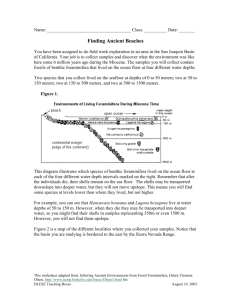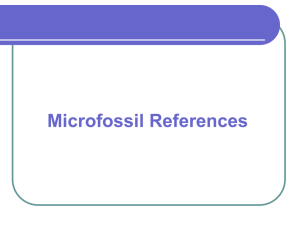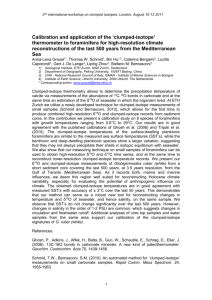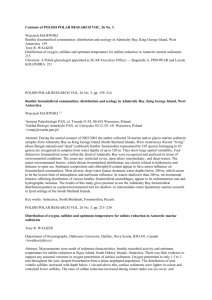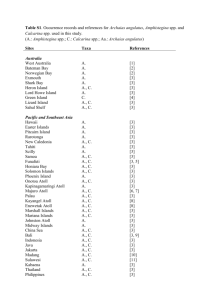Basic research methodology - UNSW, Botany Bay Studies Unit
advertisement
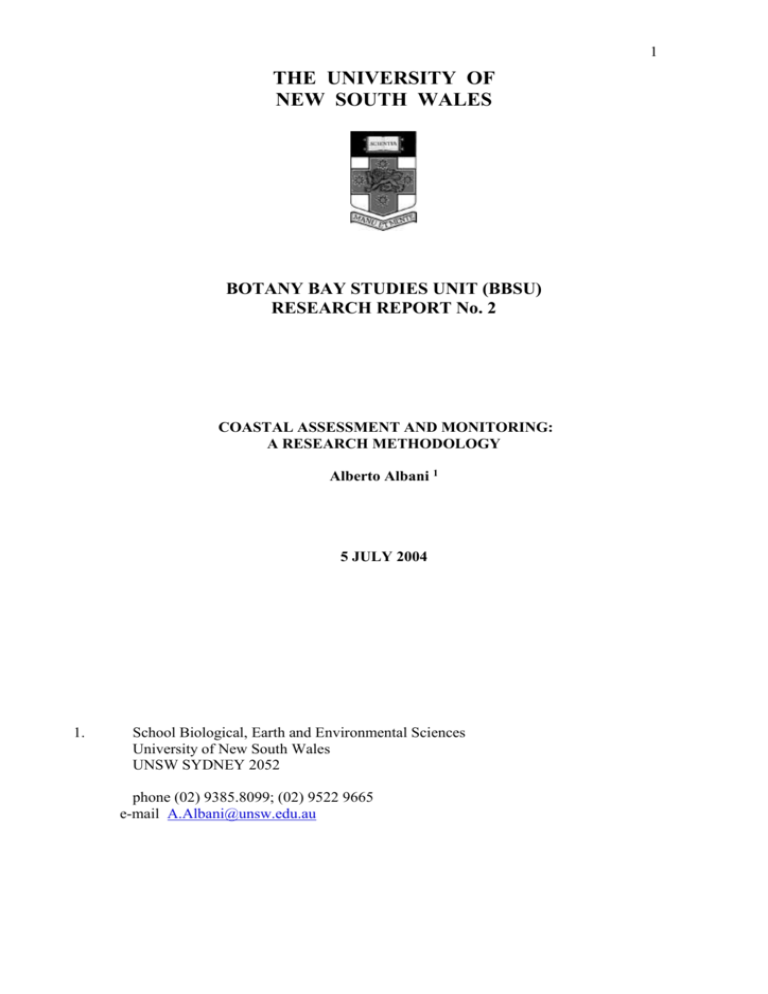
1 THE UNIVERSITY OF NEW SOUTH WALES BOTANY BAY STUDIES UNIT (BBSU) RESEARCH REPORT No. 2 COASTAL ASSESSMENT AND MONITORING: A RESEARCH METHODOLOGY Alberto Albani 1 5 JULY 2004 1. School Biological, Earth and Environmental Sciences University of New South Wales UNSW SYDNEY 2052 phone (02) 9385.8099; (02) 9522 9665 e-mail A.Albani@unsw.edu.au 2 Coastal Assessment and Monitoring: A Research Methodology During the last few decades the human impact on the marine environment and, in particular on the coastal zone, has increased enormously. One of the difficulties in establishing the level of environmental stress is the lack of reference base levels and a suitable methodology for treatment of long-term data. Any attempt to evaluate physical-chemical parameters of the water masses is, by the very nature of the measurement, time related; it gives only a snapshot of the environment. While this approach is valid for an immediate response to environmental potential disasters, either for a punitive action or/ and for a remedial action, it fails to detect and monitor subtle changes in the water qualities. A permanent record of these events is, however, available in the seabed; the distribution of benthic organisms and sediment geochemistry reflect very closely the quality of the water masses. The effects of these changes, even slight but persistent in time, have a cumulative effects on the seabed. Some benthic life is affected by the concentrations of the heavy metals in the sediments and, in turn, man is also affected via the food chain. This methodology has been applied with great success in Australian waters (Port Hacking, Broken Bay, Jervis Bay and numerous small inlets along the eastern Australian coast) as well as in several Mediterranean locations with extensive work being conducted in the upper Adriatic, the Lagoon of Venice. At present research activities are conducted in Botany Bay and more are planned in order to establish a suitable database for monitoring purposes. 1. Research description. A - Sediments - grain size characteristics. Detailed sedimentological investigations have been used to recognized sedimentary provinces; in addition, sediment data can also be used to estimate the rate of siltation and provenance of the sediment, and to give an indication of the energy levels affecting the seabed. While the traditional approach has been to evaluate the sediment characteristics based on summarizing the size distributions using statistical parameters only, the methodology adopted in evaluating the laboratory data is based on a complex statistical analysis using the totality of the data. This has been found (Albani, 3 1974; Albani & Brown, 1976; Albani et.al., 1984; Albani et al.,1991) to reveal a number of details much greater than by the traditional method and to obtain a more comprehensive understanding of the sedimentary environment. In addition the traditional approach of grain size determination, based on the physical dimensions of the particles, does not consider those other characteristics such as shape and specific gravity, which play an important role in the hydrodynamic behavior of each particle. The methodology adopted is based on the hydrodynamic size of the particles; a method which also allows a more rigorous and detailed assessment of the size distributions. B - Sediments - geochemical characteristics. The standard set of major and minor elements (SiO2, TiO2, Al2O3, Fe2O3, MnO, MgO, CaO, Na2O, K2O, P2O5, S) together with the trace elements (V, Cr, Co, Cd, Cu, Zn, Ni, Ba, Ga, Pb, Sr, Rb, Y, Sn, Ag, Zr, As, Sb, Mo, Nb, Th, U) have been selected for these investigations. Many of these are suspected to be toxic to life forms and are likely to be introduced into the area by man. This was largely guided by our experience with a similar set of samples from Broken Bay, New South Wales (Rickwood et al., 1983a) and from the Adriatic Sea (Albani et.al., 1989; Rickwood et al., 1992). Using these data, geochemical provinces are delineated and an assessment of potential source of specific elements obtained. C - Benthic foraminifera. Foraminifera are marine unicellular protozoa, which secrete a shell (test) of calcium carbonate; their size generally ranges from 0.1 to 2 mm. They are very sensitive to variations in the physical-chemical characteristics of their environment such as salinity, temperature, food availability and water depth. The high abundance of individuals (population) and the considerable variety of species (assemblage) present in a small sample of the bottom sediment, even in a restricted environment, make it possible to recognize any slight changes in the total assemblage, as well as in the various populations. Often the differences are not in the presence or absence of various species, i.e. at the assemblage level, but in the relative abundance of the various species. Because of their short life span and the fact that they secrete a shell, the occurrence of foraminifera is not restricted to the time of the sampling and it offers a time-integrated view of the water qualities. No other group of organisms appears to have similar characteristics. The main aim is to recognize ecologically similar environments, therefore it is desirable to adopt a technique, which would tend to minimize the seasonal variations. Both living and dead individuals are considered, thus eliminating the problem of repetitive sampling due to seasonal variations; an 4 integrated view, i.e. a view that includes seasonal variations, is obtained. Temporary changes in conditions, which although may produce drastic but short lived effects on the benthic population, have little impact on the overall data base as the span of time of the sampled population may be of a few years. Only those persistent conditions, which affect permanently the overall assemblage, can be recognized. Because of these capabilities, the benthic foraminifera appear to be an ideal group of organisms for long term monitoring purposes. In recent years numerous studies conducted along the eastern coast of Australia and overseas have shown that benthic foraminifera can be very effectively used to delineate ecological provinces (biotopes). The level at which the various stations link together to form the biotope, is an expression of faunal similarity. In coastal environments characterized by industrial pressures, it has been possible to identify areas with significant ecological abnormality (Albani, 1978; Albani, 1993; Albani et al., 1984; Albani and Johnson, 1975; Albani and Serandrei Barbero, 1982; Johnson and Albani, 1973) Methodology Collection Sediment from the seabed would be obtained using a small dredge and the sample is normally taken from the top 10 cm of surface material and covers an area of 1 metre of seabed; two bottom samples from the same station locality are desirable. The two samples are then mixed and a number of aliquots taken for the three analytical procedures. To obtain the initial basic data set for monitoring purposes, the number of samples and their location are dictated by the investigation requirements and the size of the target area. Sedimentology A 500 gr aliquot is homogenized and a sub portion of 50 - 60 gr is wet sieved through a 63µm nylon mesh to separate sand from silt and clay. The sand fraction is then processed using a specially designed sedimentation balance with variable sampling rate, up to 1/20 ø interval (ø= -log mm/log 2), and the silt/clay fraction analyzed using a Malvern analyser. The % values of each fraction are calculated and these data form the basis for the various correlations and for the determination of the basic standard parameters. Geochemistry Initial sample preparation 5 About 1 kg of sample is dried at 105˚C prior to thorough mixing and subdividing. An aliquot of about 500 gr is grounded in a tungsten carbide ring mill to ensure particles are < 50 µ in diameter and the resultant powder is remixed. X-ray fluorescence spectrometry. (a) Trace elements. 4-5 gr aliquots are taken from the dried, crushed sample and are pressed in a hydraulic ram to produce firm pellets suitable for XRF analyses. (b) Major elements. Further aliquots of dried, crushed powder are ignited in a furnace at 900˚C, pre- and post-weighing enabling determination of 'Loss on ignition'. Subsequent fusion of the ignited powder with lithium tetraborate is undertaken according to the well-established procedures and the resultant melts are cast as glass discs and analyzed by X-ray fluorescence spectrometry. All chemical determinations are undertaken using a Siemens SRS 300 X-ray fluorescence spectrometer (Rickwood et al., 1983a). Benthic Foraminifera Three portions of 20 cm2 each are taken from the original sample, mixed and wet sieved through a 63µm nylon mesh to eliminate silt and clay. The residue is dried and the foraminifera concentrated using a floatation method (CCl4). The concentrate generally contains an average of 10,000-20,000 individuals; this assemblage is subdivided using a microsplitter to obtain a representative population of about 1,000 individuals, which are all identified and counted. By using a pilot station additional sub samples are selected, and the foraminifera present identified and counted; these values are then added to the original count to assess the numerical significance of the population originally considered. In past experience any sub sample in addition to the 1000 individuals does not appear to change the final percentage of each population. The percentage population of each species, with respect to the total assemblage, is calculated and these values form the numerical basis for the statistical analysis. Numerical treatment of the data The three data sets are processed using a number of statistical approaches, among which factor and cluster analyses. The results are plotted on thematic maps to indicate the distributions of the sedimentary and the geochemical provinces and the foraminiferal biotopes. These maps reflect the conditions of the seabed at the time of sampling and when compared with the results from similar future studies will reveal time-related changes (environmental improvements or/and deteriorations) that form the basis for long term monitoring programs. 6 References Relevant publications only ALBANI, A.D., 1968. Recent Foraminiferida from Port Hacking, New South Wales. Contribution of the Cushman Foundation for Foraminiferal Research, 19: 85-119. ALBANI, A.D., 1970. A foraminiferal fauna from the Eastern Continental Shelf of Australia. Contribution of the Cushman Foundation for Foraminiferal Research, 21: 71-77. ALBANI, A.D., 1974. Sedimentary environments in Broken Bay, N.S.W., Australia. Journal of the Geological Society of Australia, 21: 277-288. ALBANI, A.D., 1978. Recent foraminifera of an estuarine environment in Broken Bay, New South Wales. Australian Journal of Marine and Freshwater Research, 29: 355-398. ALBANI, A.D., and BROWN, G.A., 1976. Geological Contribution to Environmental Management of Coastal Lagoons at Gosford, N.S.W. (Australia). Bulletin of the International Association of Engineering Geology, 14: 84-104. ALBANI, A.D., and JOHNSON, K.R., 1975. Resolution of foraminiferal Biotopes in Broken Bay, N.S.W. Journal of the Geological Society of Australia, 22: 435-446. ALBANI, A.D., and SERANDREI BARBERO, R., 1982. A foraminiferal fauna from the Lagoon of Venice. Journal of Foraminiferal Research, 12: 234-241. ALBANI, A.D., FAVERO, V. and SERANDREI BARBERO, R., 1984. Benthonic foraminifera as indicators of intertidal environments. Geo-marine Letters . 4: 43-47. ALBANI, A.D., RICKWOOD, P.C., FAVERO, V. and SERANDREI BARBERO, R., 1989. The Geochemical anomalies in sediments on the shelf near the Lagoon of Venive, Italy. Marine Pollution Bulletin, 20 (9): 438-442. ALBANI, A.D., RICKWOOD, P.C., NIELSEN, L. AND LORD, D. 1991. Geological and hydrodynamic conditions in Broken Bay, New South Wales. Technical Contribution Series. 1. Centre for Marine Science, Univ. N.S.W.: Sydney. ALBANI, A.D. 1993. Use of benthonic foraminifera to evaluate the environmental characteristics of Port Hacking; significance for coastal engineering works and pollution. In G. McNally, M. Knight, & R. Smith (Eds.), Collected Case Studies in Engineering Geology, Hydrogeology and Environmental Geology (pp. 134). Geological Society of Australia: Sydney. ALBANI, A.D., RICKWOOD, P.C., FAVERO, V. and SERANDREI BARBERO, R., 1995 - The geochemistry of recent sediments in the Lagoon of Venice: environmental implications. Istituto Veneto di Scienze, Lettere ed Arti, Atti, 153: 235-321. ALBANI, A.D., FAVERO, V. and SERANDREI BARBERO, R., 1998 - Distribution of Sediment and Benthic Foraminifera in the Gulf of Venice, Italy. Estuarine, Coastal and Shelf Science, 46 (2): 252-265 ALBANI, A.D. and SERANDREI BARBERO, R., 2001. The distribution of surface sediments in the Lagoon of Venice (Italy) in the 1980s. Istituto Veneto di Scienze, Lettere ed Arti, Atti, 154: 363-378. JOHNSON, K.R. and ALBANI, A.D., 1973. Biotopes of Recent benthonic foraminifera in Pitt Water, Broken Bay, N.S.W. Palaeogeography, Palaeoclimatology, Palaeoecology, 14: 265276. RICKWOOD, P.C., 1983. Cluster analysis of geochemical data. In The significance of trace elements in solving petrogenetic problems and controversies (Augustithis, S.S., ed) Theophrastus Publications S.A., Athens, pp.116 - 124 RICKWOOD, P.C., ALBANI, A.D. and CHORLEY, G.I., 1983 a. The relationship between sediment composition and the distribution of benthic foraminifera in Broken Bay, New South 7 Wales, Australia. In The significance of trace elements in solving petrogenetic problems and controversies (Augustithis, S.S., ed) Theophrastus Publications S.A., Athens, pp.135 - 147. RICKWOOD, P. C., ALBANI, A. D., FAVERO, V. M., & SERANDREI BARBERO, R. 1992. The geochemistry of unconsolidated sediments from the Gulf of Venice, Italy. Technical Contribution Series. 3. Centre for Marine Science, Univ. N.S.W.: Sydney. RICKWOOD, P.C., COLON E., DOBOS, V.J., GUY, J.V., GWATKIN, C.G., POOLE, R. and WAINWRIGHT I.E., 1983 b. The origin of basalt in the Blue Mountains near Sydney, New South Wales, Australia. In The significance of trace elements in solving petrogenetic problems and controversies (Augustithis, S.S., ed) Theophrastus Publications S.A., Athens, pp.124 - 135.


